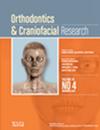Small nucleolar RNA host gene 5 plays a role in orthodontic tooth movement by inhibiting osteoclast differentiation
Abstract
Background and Objectives
The alveolar bone remodelling promoted by reasonable mechanical force triggers orthodontic tooth movement (OTM). The generation of osteoclasts is essential in this process. However, the mechanism of mechanical force mediating osteoclast differentiation remains elusive. Small nucleolar RNA host gene 5 (SNHG5), which was reported to mediate the osteogenic differentiation of bone marrow mesenchymal stem cells in our previous study, was downregulated in human periodontal ligament cells (hPDLCs) under mechanical force. At the same time, the RANKL/OPG ratio increased. Based on this, we probed into the role of SNHG5 in osteoclast formation during OTM and the relevant mechanism.
Materials and Methods
SNHG5 and the RANKL/OPG ratio under different compressive forces were detected by western blotting (WB) and qRT-PCR. Impact of overexpression or knockdown of SNHG5 on osteoclast differentiation was detected by qRT-PCR, WB and transwell experiments. The combination of SNHG5 and C/EBPβ was verified by RNA immunoprecipitation and RNA pull-down assays. The expression of SNHG5 and osteoclast markers in gingiva were analysed by qRT-PCR and the paraffin sections of periodontal tissues were used for histological analysis.
Results
Compressive force downregulated SNHG5 and upregulated the RANKL/OPG ratio in hPDLCs. Overexpression of SNHG5 inhibited RANKL's expression and osteoclast differentiation. SNHG5 combined with C/EBPβ, a regulator of osteoclast. The expression of SNHG5 in periodontal tissue decreased during OTM.
Conclusion
SNHG5 inhibited osteoclast differentiation during OTM, achieved by affecting RANKL secretion, which may provide a new idea to interfere with bone resorption during orthodontic treatment.

 求助内容:
求助内容: 应助结果提醒方式:
应助结果提醒方式:


